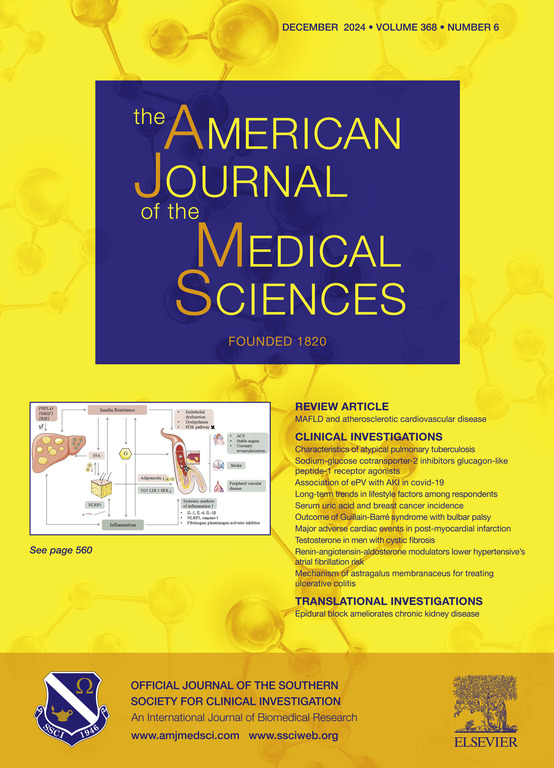癌症患者败血症的流行病学和预后:多中心前瞻性观察研究》。
IF 2.3
4区 医学
Q2 MEDICINE, GENERAL & INTERNAL
引用次数: 0
摘要
目的:确定癌症患者败血症的流行病学和预后,以及败血症对癌症患者死亡率的影响:确定癌症患者败血症的流行病学和预后,以及败血症对癌症患者死亡率的影响:在这项多中心、前瞻性、观察性研究中,纳入了未患败血症的住院癌症患者,随访至出院或最长 90 天。研究确定了随访期间败血症的发生率、败血症的风险因素、败血症患者 28 天死亡率的风险因素以及整个研究组 90 天死亡率的风险因素:研究期间共纳入了 790 名癌症患者。在随访期间,有 72 名患者(9.1%)发生了败血症。年龄较大、因任何感染住院、移植物抗宿主疾病(GVHD)、有尿道导管以及在过去三个月中有过细菌感染是导致败血症的风险因素。在所有癌症患者中,败血症是影响 90 天死亡率的最重要因素(OR 13.42(1.79-6.83))。脓毒症组群的死亡率与耐碳青霉烯类细菌感染(OR 15.47(1.45-64.17))、经验性治疗的适当性(OR 5.02(0.17-7.61))和治疗第五天临床症状改善(OR 10.58(0.39-28.25))独立相关:结论:每11名住院癌症患者中就有1名出现败血症,一旦出现败血症,死亡率将增加13倍。侵入性设备、GVHD 和既往细菌感染与败血症有关,抗生素耐药性是导致死亡的最重要因素。抗菌药物管理、合理使用导管(必要时按照无菌/反无菌操作,短期使用)对于挽救癌症患者的生命非常重要。本文章由计算机程序翻译,如有差异,请以英文原文为准。
Epidemiology and prognosis of sepsis in cancer patients: A multicenter prospective observational study
Objectives
To determine the epidemiology and prognosis of sepsis in cancer patients and the influence of sepsis on the mortality of cancer patients.
Methods
In this multicenter, prospective, observational study, cancer patients hospitalized without sepsis followed up until discharge or a maximum of 90 days were included. The incidence of sepsis in the follow-up period, risk factors for sepsis, risk factors for 28-day mortality in patients with sepsis and 90-day mortality in the entire group were determined.
Results
During the study, 790 cancer patients were included. Sepsis developed in 72 patients (9.1 %) during the follow-up. Older age, hospitalization due to any infection, graft versus host diseases (GVHD), the presence of a urethral catheter, and previous bacterial infection in the last three months were risk factors of sepsis. Among all cancer patients, sepsis was found to be the most important factor influencing 90-day mortality (OR 13.42(1.79–6.83)). Mortality among the sepsis cohort was independently associated with an infection with a carbapenem-resistant bacterium (OR 15.47(1.45–64.17)), appropriateness of empirical treatment (OR 5.02 (0.17–7.61)) and having a clinical improvement on the fifth day of the treatment (OR 10.58(0.39–28.25)).
Conclusions
Sepsis was documented in one out of 11 hospitalized cancer patients and the mortality rate increases 13-fold when sepsis develops. Invasive devices, GVHD, and previous bacterial infections were related to sepsis and antibiotic resistance were the most important driver for mortality. Antimicrobial stewardship, rational use of catheters (if necessary, in accordance with asepsis/antisepsis, short-term use) is important to save lives in cancer patients.
求助全文
通过发布文献求助,成功后即可免费获取论文全文。
去求助
来源期刊
CiteScore
4.40
自引率
0.00%
发文量
303
审稿时长
1.5 months
期刊介绍:
The American Journal of The Medical Sciences (AJMS), founded in 1820, is the 2nd oldest medical journal in the United States. The AJMS is the official journal of the Southern Society for Clinical Investigation (SSCI). The SSCI is dedicated to the advancement of medical research and the exchange of knowledge, information and ideas. Its members are committed to mentoring future generations of medical investigators and promoting careers in academic medicine. The AJMS publishes, on a monthly basis, peer-reviewed articles in the field of internal medicine and its subspecialties, which include:
Original clinical and basic science investigations
Review articles
Online Images in the Medical Sciences
Special Features Include:
Patient-Centered Focused Reviews
History of Medicine
The Science of Medical Education.

 求助内容:
求助内容: 应助结果提醒方式:
应助结果提醒方式:


